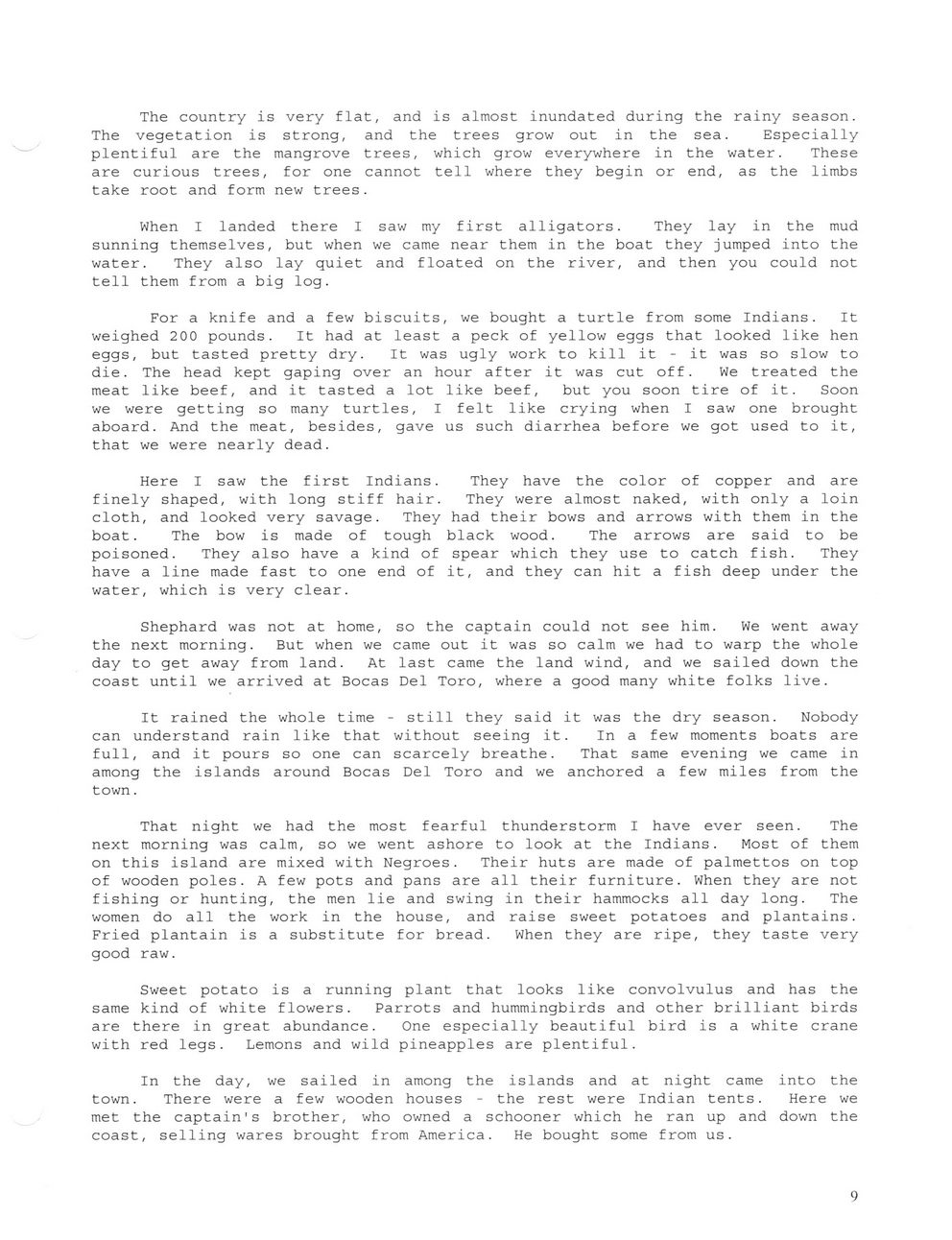This text was obtained via automated optical character recognition.
It has not been edited and may therefore contain several errors.
The country is very flat, and is almost inundated during the rainy season. The vegetation is strong, and the trees grow out in the sea. Especially plentiful are the mangrove trees, which grow everywhere in the water. These are curious trees, for one cannot tell where they begin or end, as the limbs take root and form new trees. When I landed there I saw my first alligators. They lay in the mud sunning themselves, but when we came near them in the boat they jumped into the water. They also lay quiet and floated on the river, and then you could not tell them from a big log. For a knife and a few biscuits, we bought a turtle from some Indians. It weighed 200 pounds. It had at least a peck of yellow eggs that looked like hen eggs, but tasted pretty dry. It was ugly work to kill it - it was so slow to die. The head kept gaping over an hour after it was cut off. We treated the meat like beef, and it tasted a lot like beef, but you soon tire of it. Soon we were getting so many turtles, I felt like crying when I saw one brought aboard. And the meat, besides, gave us such diarrhea before we got used to it, that we were nearly dead. Here I saw the first Indians. They have the color of copper and are finely shaped, with long stiff hair. They were almost naked, with only a loin cloth, and looked very savage. They had their bows and arrows with them in the boat. The bow is made of tough black wood. The arrows are said to be poisoned. They also have a kind of spear which they use to catch fish. They have a line made fast to one end of it, and they can hit a fish deep under the water, which is very clear. Shephard was not at home, so the captain could not see him. We went away the next morning. But when we came out it was so calm we had to warp the whole day to get away from land. At last came the land wind, and we sailed down the coast until we arrived at Bocas Del Toro, where a good many white folks live. It rained the whole time - still they said it was the dry season. Nobody can understand rain like that without seeing it. In a few moments boats are full, and it pours so one can scarcely breathe. That same evening we came in among the islands around Bocas Del Toro and we anchored a few miles from the town. That night we had the most fearful thunderstorm I have ever seen. The next morning was calm, so we went ashore to look at the Indians. Most of them on this island are mixed with Negroes. Their huts are made of palmettos on top of wooden poles. A few pots and pans are all their furniture. When they are not fishing or hunting, the men lie and swing in their hammocks all day long. The women do all the work in the house, and raise sweet potatoes and plantains. Fried plantain is a substitute for bread. When they are ripe, they taste very good raw. Sweet potato is a running plant that looks like convolvulus and has the same kind of white flowers. Parrots and hummingbirds and other brilliant birds are there in great abundance. One especially beautiful bird is a white crane with red legs. Lemons and wild pineapples are plentiful. In the day, we sailed in among the islands and at night came into the town. There were a few wooden houses - the rest were Indian tents. Here we met the captain's brother, who owned a schooner which he ran up and down the coast, selling wares brought from America. He bought some from us. 9

Koch, Christian Diary-09